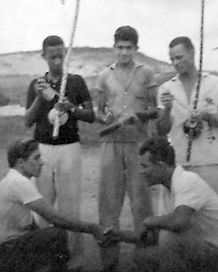History of Cordao de Ouro

The first students of Mestre Suassuna in Itabuna - Bahia. From left to right standing Chico Minuto, Garrincha and Clido. Crouched, Master Suassuna and Police.
And known as Luizinho - Mestre Luís Medicina, who stood out at the time, today Master of the Race Group.
The Association of Capoeira Cordão de Ouro was founded by Mestre Suassuna in the 60's, more exactly on September 1, 1967, together with Mestre Brasília, at a time of major festivals of Brazilian popular music. Upon hearing the chorus of the song above on a radio, the two, already with the idea of opening a gym, decide to use the name Golden Cord,because it is Beetle Cord of Gold, a capoeirista before the division Angola and Regional. Mestre Suassuna would teach Capoeira Regional and Mestre Brasília Capoeira Angola within the same space. After a short period, Mestre Brasília decided to found his own group, São Bento Grande.
In this difficult time for capoeira, when the persecution of dictatorship and prejudice hindered its development in the south of the country, Mestre Suassuna, from Bahia from Itabuna, recently arrived in São Paulo, continued the work and presented himself insistently, showing the techniques of the game and struggle, opening the first academy in the capital of São Paulo. With intense work, it did not take long to have his first students, such as Lobão, Esdras Filho, Tarzan, Belisco, Almir das Areias, Caio, and many others.
It housed capoeiristas from the north and northeast who arrived here, in order to better spread the art of capoeira, making their academy the reference for the formation of a large crop of new masters in São Paulo soil. Capoeira Cordão de Ouro was the birthplace of many prominent names. In addition to those already mentioned, came the Masters Flavio Toucan, Biriba, Dal, Marcelo Caveirinha, Urubú Malandro, Espirro Mirim, Xavier, Lúcifer, Torinho, Pial, Cangurú, Sarará, Zé Antônio, Ponciano, Bolinha, Geraldinho, without forgetting also Mestre Cícero, Mestre Zé Carlos and Mestre Penteado, who despite being grandchildren students have an invaluable value for Mestre Suassuna and grupo Cordão de Ouro, among many who would complete an immense list.
Always restless Mestre Suassuna never settled, keeping his work continuously recycled, creating after years, the Jogo do Miudinho. A new team of capoeiristas would enrich their collection of counter master: Boca Rica, Habibs, Mintirinha, Kibe, Denis, Saroba, Coruja, Chicote, Chiclete, Kino, Pintado, Lú Pimenta, Barata, Esquilo, Romualdo and others, rulers of a new game rich in plastic movements, better known as the Miudinho generation.
Today, with numerous branches in Brazil and abroad, the Cordão de Ouro Group has a prominent role among all capoeira groups, not only for what The Master Suassuna represents for sport and culture, but also for the effort undertaken by him and his supporters. In order to keep capoeira at a highly technical level, interacting speed, agility, elasticity, creativity, music and malice, without forgetting its roots.
This effort has been compensated by the dedication of capoeiristas who follow the group's philosophy.

Mestre Cicero (left) and Grand Mestre Suasunna
Mestre Cícero
At the age of 15, Cícero Gabriel left Paraná looking for something to do. He lived in Foz do Iguaçu and Pindamonhangaba. He traveled Brazil outside until arriving in Campinas / São Paulo. He came across something he had never seen before and soon turned into a great passion. Passion that arose from a chance meeting on a trip to Santos/ São Paulo. It was a capoeira roda with only five people by the sea. Pun of fate returning to Campinas found the academy Beira Mar of Master Tarzan who asked him the following question: - Do you want to attend a class? And then he said, "I want to start training."
He trained for years until he graduated with a Master's degree. Capoeira then became his profession from then on, his life was just running after rodas, baptisms, events and new teachings. He competed in the São Paulo Championship of '87 bringing the title of light heavyweight champion. At first it was just leisure, he confesses. Where he met several people and met with friends.
He met Master Suassuna in one of the courses he taught. He went on to attend all the baptisms of the group and together with Mestre Suassuna went to Rio de Janeiro for the first time, where he met great Masters such as Mestre Gato, Mestre Peixinho, Mestre Toni, Mestre Ramos, Mestre Paulinho Sabiá among others.
In 89 he was in Bahia, also for the first time, where Mestre Suassuana told him to look for Master João Pequeno and Mestre João Grande, that's when he met and met, in addition to the two greatest characters in the world of capoeira from Angola, Mestre Luís Medicina, his old brother, as he himself refers, Mestre Jogo de Dentro with whom he still exchanges knowledge. Invited to be part of the group Golden Cord (CDO) did not hesitate and it is with great pride that he is part of this great family.
